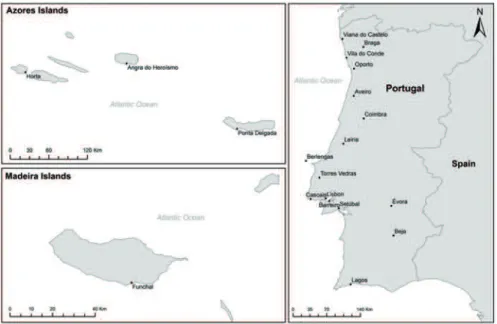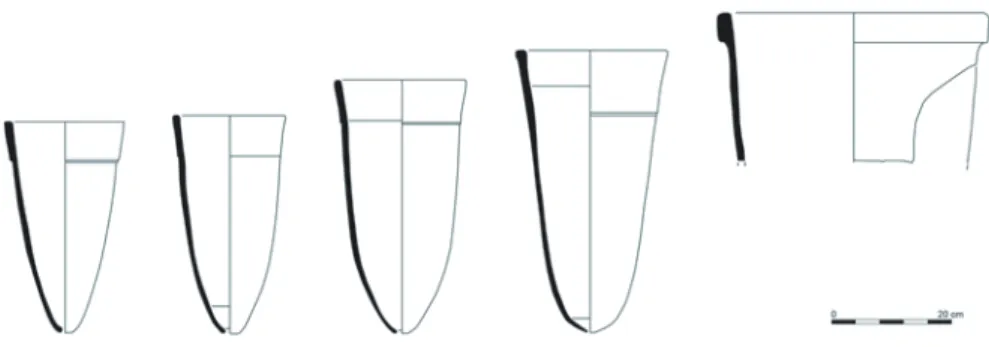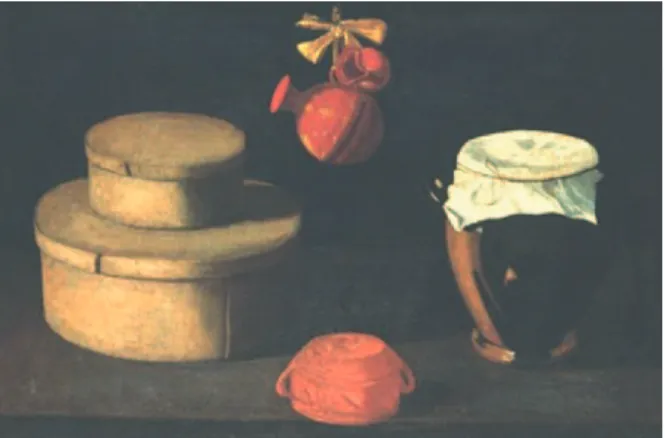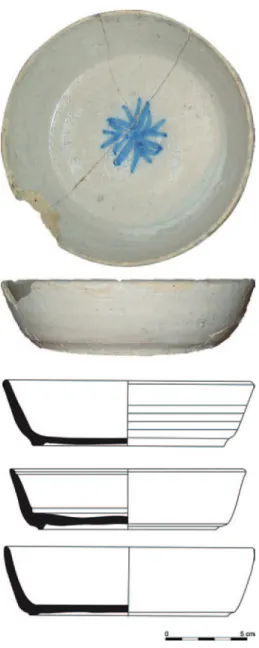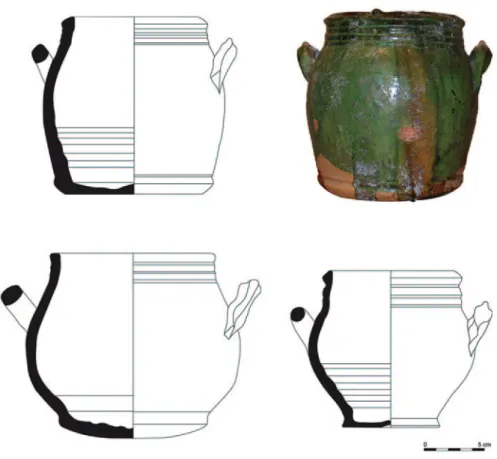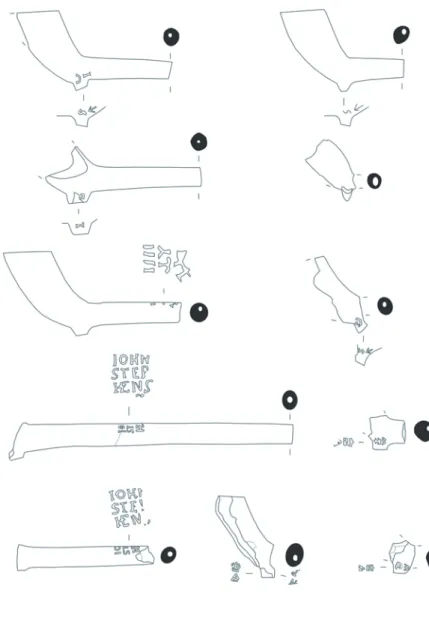19
The Atlantic Expansion and the Portuguese
Material Culture in the Early Modern Age:
An Archaeological Approach
André Teixeira, Joana Bento Torres and José Bettencourt
© Springer International Publishing Switzerland 2015
P. P. A. Funari, M. X. Senatore (eds.), Archaeology of Culture Contact and Colonialism in Spanish and Portuguese America, DOI 10.1007/978-3-319-08069-7_2
A. Teixeira () · J. Bento Torres · J. Bettencourt
Faculdade de Ciências Sociais e Humanas, CHAM, Avenida de Berna, 26C, 1069-061 Lisboa, Portugal
e-mail: texa@fcsh.unl.pt
J. Bento Torres
e-mail: joanabtorres@gmail.com
J. Bettencourt
e-mail: jbettencourt.cham@gmail.com
2.1
Introduction
The Portuguese expansion in the Atlantic was undoubtedly one of the pioneering highlights of early modern Europe, along with the Spanish exploration of America. Once this was the world’s region with least communications, the extensive contact with the Iberian navigations led to interchanges in almost all dimensions of human life. In this chapter, we review the impact of these exchanges in Portugal through ar-chaeology. The attempt is to determine the presence of exogenous products among Portuguese everyday life material culture and the changes carried out in the country to enable this colonial enterprise. The Atlantic is approached as a whole, given the exchanges and complementarities here occurred during the Early Modern Age, although with particular focus on Brazil, for the hegemonic weight that it quickly acquired within this framework.
This is a field of research that has been developed in Portugal from written
sourc-es and artistic objects (Trnek and Silva 2001; Henriques 2009). These approaches
reflect the consumptions and the spaces of the elites and hence do not show the extent of the contact, in a broader sense, in the Portuguese society. The ones with a more global approach demonstrate an important penetration of material culture elements from the overseas in small coastal villages. This is the case of Vila do
Conde (Fig. 2.1), where wills, inventories, and other records of the sixteenth
on extends the range and quantity of American products, reducing the presence of oriental goods, thus, following the decrease of travels flow undertaken from
this port, from Atlantic islands and the Indian Ocean to Brazil (Polónia 2007,
pp. 174–181 and 448–451).
In fact, the Early Modern Age archaeology in Portugal is underdeveloped, so its contribution in these issues has been limited. The multiple field works within the urban archaeology do not match an identical volume of publications and research projects. This is the result of contract archaeology circumstances and the faded
presence of this field in the Portuguese academia (Sousa 2010, pp. 10–15).
The archaeological studies of contact material culture in Portugal have been cen-tered in Asia, for the prestige of the orientalism, but also for its expression in the archaeological record. Porcelain and other eastern ceramics were brought in large quantities to Europe, resulting in a significant, continued, and progressive presence in Portuguese contexts, from the wealthy classes to the common population, even though synthesis studies are still lacking. Other Asian products have a more residual occurrence, such as spices, fabrics, or precious stones, present mostly in shipwrecks of the sea route to India, namely the presumed remains of the Nossa Senhora dos
Mártires, wrecked at the entrance of Lisbon in 1606 (Brigadier 2002). Also note the
cowrie shells, gastropod molluscs with important currency and symbolic functions in Africa and Asia, frequently present in the archaeological record. We highlight the cargo aboard the ships of the return trip from the Indian Ocean, as exemplified by the Nossa Senhora da Luz, foundered in 1615 near Horta, Azores (Bettencourt
2006). The study of India sea route logistics is also more consolidated than that of
the Atlantic ones, since it was managed by an institution based on the ground floor of the royal palace in Lisbon (Costa 1997; Caetano 2004).
At the same time, note the scarce visibility of Brazilian goods in the archaeo-logical record, including sugar, tobacco, woods, fruits and other vegetables, animals (alive or in furs), or cotton, mostly due to its perishable condition. We exclude the gold or diamonds, with a turnout during the eighteenth century, by its enormous monetary value. The same is valid with goods brought from Africa, such as ivory, fabrics, chilli pepper, or even slaves. Also, the logistic structures of this trade came to light more recently, through urban archaeology. Thus, the text here presented is mainly a starting point for the study of this issue, looking to provide some clues for a global understanding of the impact, in the Portuguese everyday life, of the rela-tions developed with people bordering the Atlantic, especially Brazil.
2.2 Sugar: The Industrial Ceramics
and the Sweet Consumption
Sugar was the main drive for the Portuguese expansion in the Atlantic, regardless of its production in southern Europe during the Middle Ages, including Portugal. It was first experimented in Madeira with great accomplishment, and then took to the Cape Verde and São Tomé and Príncipe archipelagos, the latter with thriving suc-cess. In the second half of the sixteenth century, the sugarcane and its mills expand-ed to Brazil, with remarkable production volumes in the following century. These inhibited other local economic activities and flooded the European markets with sugar. The consumption was no longer a prerogative of the most favored groups, wide-spreading to society in general. After crossing the Atlantic packed in wooden boxes as the bulk of the cargo on the route between Brazil and Portugal, sugar was unloaded in Lisbon, but also with great expression in Oporto or in Viana. The con-nections to the American colony became the main destination of the trading activity of these ports, even in times of crisis or war. The product was later sold in Portu-gal or shipped to other Atlantic European cities, by Portuguese as well as foreign
merchants (Mauro 1997; Costa 2002). The importance of sugar in Early Modern
Portuguese economy is demonstrated in archaeology by two factors: the ceramics designed for its production and the objects related with its consumption.
In the first case, we speak mainly of the so-called sugar moulds, a conical vessel
with an orifice in the bottom to purge the product (Mauro 1997, pp. 265–277). So
far, there were two main production centers recognized in Portugal. The first, with a known production in the fifteenth and sixteenth century, was located on the left bank of the Tagus estuary, facing Lisbon, in a space that for centuries served as the industrial area of the capital. At the time, it was integrated in a structure complex meant for the overseas expansion, such as the biscuit factory or shipyards (Torres
1990; Barros et al. 2006; Silva 2012). The second, operating in the sixteenth and
and of intensive fishing activity, both coastal and deep sea (Coelho 2012; Morgado et al. 2012).
The dissemination of these ceramic forms is poorly known. In Portugal, they were detected and associated to a monastery from the first half of the sixteenth century in the Berlengas islands, suggesting that the sugar loaves contained in those forms were given as payment for supplies during a port of call (Lourenço and Bugalhão
2006). In Madeira archipelago, the link between the forms from Aveiro and the
sugar production was already established to the sixteenth and seventeenth centuries. It is clear that these islands imported them in order to solve their lack of clays, as
they would do with other ceramic forms (Sousa 2011). The same thing would have
happened in Azores, despite the lesser importance of this product, and in the Canary Islands, which imported these and other ceramics from Aveiro even though it was a Spanish colony. The dissemination of red micaceous pottery from this region is, in fact, attested in a wide area including the western European front and North
America (Bettencourt and Carvalho 2008). However, it is not clear if there was a
supply of sugar moulds to other Atlantic sugar production centers, namely in the
primitive Brazilian mills, such as in São Jorge dos Erasmos (Andreatta 1999).
Concerning the sugar consumption, at start, it was used for mainly therapeutic purposes, found in apothecaries as an ingredient for medicinal solutions. Apoth-ecaries could either be in a specific room in the house or a more indistinctive area where its objects were gathered. In this set, there were conserved fruit, marmalades and candied fruit peel (usually of citrus fruit), as well as rose and violet sugar, fre-quently acting as an energy supplement, and sometimes used to fight scurvy or even
fever (Nunes 2002, p. 160; Algranti 2005, p. 42). Regarding the stocking of these
preparations, it is clear that the type of containers is basically the same throughout the early modern age, both in documentation and iconographic representations, as well as in the archaeological record.
The marmalades were usually kept in wooden boxes, namely visible in the still
lifes of Juan van der Hamen y León, Josefa de Óbidos (Fig. 2.3), Francisco de
Zurbarán, or Luís Meléndez, therefore hard to find in archaeological contexts. But this product is also present in small glass containers, such as small jugs or bowls, or in small clay basins. With the second half of the seventeenth century, came a
new ceramic form, the covilhete (Fig. 2.4), a “small vase of clay with a concave
surface,” specifically associated to sweets packing and consumption (Bluteau 1712,
v. 2, p. 594). This type has a more systematic presence in archaeological contexts.
On one hand, in convent spaces, as São Francisco de Lisboa (Torres 2011), Salvador
de Évora (Mangucci 2007), Santana de Leiria (Trindade 2013), or Bom Jesus de
Setúbal (Almeida 2012). On the other, in civil buildings, like the Casa do Infante,
in Oporto (Barreira et al. 1995, pp. 145–184), or in the Paços do Concelho of Torres
Vedras (Luna and Cardoso 2006, pp. 99–112). Its production in Lisbon is
docu-mented in the second half of the seventeenth century (Batalha et al. 2012).
In the specific case of conserved fruit and of rose and violet sugar, written
sourc-es mention the general use of glazed pots and pans (Fig. 2.5). These containers are
present in several Portuguese and Brazilian archaeological sites of the seventeenth century, especially in convents. As an example, note São Francisco de Lisboa (Torres
2012), Nossa Senhora da Piedade de Cascais (Cardoso and Rodrigues 2002), but
also the aforementioned Paços do Concelho of Torres Vedras (Luna and Cardoso
2006, pp. 99–112). Its production is established for the fifteenth and sixteenth
cen-tury in the industrial area of Barreiro (Carmona 2005). Not being an exclusive item
of religious background, the presence of this kind of objects is more frequently observed in places belonging to socially favored strata. Coated with lead glaze with shades of green, yellow, and brown, they possess a spherical form, usually with an inverted rim with an outer thickening, under which we find a set of incised lines marking a slight narrowing on the body. According to the paintings of Josefa de Óbidos, these vessels were covered with a cloth and sealed with a small string, which would easily fit those lines. In the upper part of the body, there was a handle on each side, horizontal or vertical.
Throughout the sixteenth and seventeenth century, there was a widespread of these products’ consumption associating fruit and sugar, becoming increasingly part of the regular meals, even though they were still kept in or near the apothecaries. Sugar also became a condiment used in small portions while cooking meals, as shown by the coeval recipes, where there is a clear taste for the contrast between the sweet and salty (Scully 1995). It is also used in large quantities as the key ingredient
in confectionery, as in the making of fartéis, comfits, and blancmange, the most popular of the time. This incorporation of sugar in the food habits happened mostly in the higher strata of the Portuguese society, continuously replacing the use of honey as a natural sweetener.
These changes initially took place in the apothecaries of the main noble houses, highlighting the role of the women who specifically make the conserves within those who worked at those places. It is interesting to note that, contrary to what hap-pened in most apothecaries, managed by a male apothecary, in these nobiliary envi-ronments these spaces are generally related to the feminine universe, falling to the
apothecary only the making or delivering of medicines (Dias 2007). This relation
was strengthened throughout the seventeenth and eighteenth centuries, becoming even clearer because of the connection between the confectionery and women, par-ticularly in feminine convents, a fact that had major repercussions in the culinary and food habits of the time. Finally, the sugar will eventually become increasingly ubiquitous, being served at the table in sugar bowls, whose characteristics are dif-ficult to determine for these chronologies.
2.3 Tobacco and Smoking Pipes
The introduction of tobacco in Portugal through Brazil is dated from the 1530s or 1540s. It was tried by early settlers in South America, curious about the habit of the Amerindians of consuming tobacco and its alleged medicinal effects. It was initially purchased locally, and afterwards became extensively grown. In Lisbon, there are references to the habit of chewing tobacco among the sailors as early as 1558. Its consumption by inhalation was accounted in documentation from Brazil in the 1580s (Silva and Guinote 1998, p. 87). In the early seventeenth century it was
already the second most exported good originating from those lands into Portugal, right after sugar, leading to the laying of a strict and profitable regal monopoly. Its use became socially widespread, reaching a large percentage of the adult
popula-tion by the end of that century (Caldeira 2000). Tobacco use was also disseminated
through Europe of the seventeenth century, a time where it was also in high demand in Africa, even reaching the shores of the Indian Ocean. It left a remarkable archae-ological record during the early modern age by the frequent presence of ceramic pipes.
In Portugal, there are still no systematic studies of these artefacts, preventing the analyses of tobacco diffusion in chronological, spatial and socioeconomic terms. This obstacle is further increased by the peninsular habits, where tobacco would be preferably consumed as snuff. Unlike other European countries, the use of the pipe and smoking was socially less prestigious in Portugal until the end of the eighteenth
century, when compared for example, to inhalation (Caldeira 2000). Being the
trad-ing of Brazilian tobacco evidently clear in Portuguese historiography, this differ-ence appears to be confirmed by the archaeological record, where no pipes for the early seventeenth century are known. These are common, for example, in the British Isles and in the Netherlands, or in the colonial spaces under their influence in the
American continent, such as Jamestown (Straube and Luccketti 1996, pp. 26–27).
Note also the frequent presence of pipes in English and Dutch shipwrecks operating in the Atlantic from the early seventeenth century, as the English ship Sea Venture
of 1609, found in the Bermuda (Wingood 1986, p. 152), or the presumably Dutch
ship from mid-seventeenth century of Monte Cristi, surveyed in the Dominican
Re-public (Hall 2006). Sometimes massive presence of pipes contrasts with an absence
or scarce expression in coeval Iberian contexts.
In any case, the presence of pipes occurs in Portuguese archaeological sites, mostly of North European kaolin productions, but also from the Mediterranean and of pre-discoveries tradition, connected with the consumption of other substances. There is discussion about a possible manufacture in Lisbon, in earthenware, which
also appears in Cascais (Silva and Guinote 1998, p. 89; Rodrigues et al. 2012,
pp. 872–874). The North European pipes are mostly in deposits of the second half of the seventeenth century or of the eighteenth century, excavated in Lisbon (Calado et al. 2003; Pinto et al. 2011), Cascais (Rodrigues et al. 2012), Porto (Pereira 2000),
or in Madeira island (Sousa 2011). Most are fragments sorted from landfill
mate-rials without precise socioeconomic reference. They are, however, also found in archaeological contexts: military, such as the forts of São João Baptista and of São
José in Madeira island (Sousa 2011); from hospitals, like the All Saints in Lisbon;
from prisons in São Jorge castle from Lisbon (Calado et al. 2003); or from
house-holds, such as the Casa dos Bicos in the capital’s riverside (Silva and Guinote 1998, p. 89). The frequent presence of pipes in the main Portuguese ports, in anchorage
areas, is also an interesting aspect. Such is the case of Lisbon1, Aveiro (Coelho
2012), or Angra (Bettencourt and Carvalho 2010).
1 See the report directed by one of us (José Bettencourt) about Boavista 1 and Boavista 2 ships,
The pipes are mainly from several production centres of the British Isles or the
Netherlands. For example, among the pipes of the São Jorge castle (Fig. 2.6), the
brands identified were mostly Dutch from Gouda, but also from Harlem or Contrai,
and British, from Hartlepool, London, Newcastle, or Bristol (Calado et al. 2003).
The same diversity was registered in the Mercado da Ribeira, also in the capital (Pinto et al. 2011), or in the Casa do Infante, in Oporto (Pereira 2000). It is from
these cities, the Portuguese main ports, that we find the largest collection published so far in Portugal, even though in small numbers, with less than a thousand frag-ments, mostly stems.
2.4 The Wood: From Dyes and Furniture to
Shipbuilding—Mutations in Lisbon’s Seascape
The trading of tropical timber acquired from the Amerindians was the first eco-nomic driving force of the Portuguese presence in Brazil during the first half of the sixteenth century. At this stage, the several types of brazilwood therein were overwhelmingly predominant in the cargo volume transported to Europe. This tree species, once grounded, was used in the production of red dyes. The gross profit of this trade in regal revenues grew throughout that century and the beginning of the following, although its share in the whole Brazilian income had been quickly overtaken by sugar. Yet, timber kept being amply exploited, given the considerable profits made by the settlers, even fearing for its extinction. The brazilwood was then transported to Portugal in logs as ballast of sugar shipments and thence to Eu-ropean textile industries. Other secondary uses for this and other Brazilian timber were documented in written sources, such as construction and shipbuilding and the
manufacture of boxes and furniture (Mauro 1997, p. I, pp. 166–200). Nevertheless,
it is found that, at least until the end of the eighteenth century, the exploitation and export of dye-producing wood greatly surpassed in quantity and profit, that which was used for furniture (Valente 2007, p. 235).
Given the perishable nature of these materials, part of these objects can only be found in art collections. See the case of the Arraiolos tapestries of the Museu Nacional Machado de Castro, in Coimbra, dated from the seventeenth century, whose red wool thread was demonstrated to be coloured with a brazilwood dye
(Marques 2007). In terms of furniture made with wood from Brazil, there are no
known archaeological evidences, remaining only studs, plates, locks, handles, or
metal chains, which may indicate their types (Torres 2012). In art collections, we
find several furniture specimens made with Brazilian wood, such as the yellow
pequia, the red angelim ( Dinizia Excelsa Ducke), the sucupira ( Pterodon
emar-ginatus), the pau-rosa ( Aniba rosaeodora), the pau-santo, pau-preto, or jacarandá ( Dalbergia nigra), the freijó ( Cordia goeldiana), the gonçalo-alves ( Astronium fraxinifolium) (Pinto 2005; Mendonça 2008, pp. 15–29). Among them, we find chairs with various shapes from Oporto, Viana do Castelo, or Braga, a sewing table from Beja, another table from Ponta Delgada, a cabinet from Viana do Castelo, another one from Braga and two from Lisbon, two trunks from Lisbon and two from Vila do Conde, an inkstand from Viana do Castelo and a writing cabinet from Évora, all of which were from ancient religious buildings and with variable chro-nologies ranging from the late fifteenth century to the eighteenth century (Pinto
